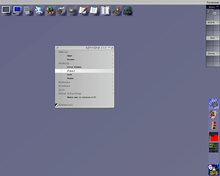 Screenshot of an AfterStep desktop. | |
| Stable release | |
|---|---|
| Repository | |
| Written in | C |
| Operating system | Unix-like |
| Type | Window manager |
| License | 2.x: MIT[3] 1.x: GPL-2.0-or-later[4] |
| Website | www.afterstep.org |
AfterStep is a stacking window manager for the X Window System. The goal of AfterStep's development is to provide for flexibility of desktop configuration, improved aesthetics and efficient use of system resources, and was used in such distributions as MachTen. AfterStep originally was a variant of FVWM modified to resemble NeXTSTEP, but as the development cycle progressed, it diverged from its FVWM roots. In 2000, Linux website TuxRadar selected AfterStep as one of the year's best window managers, praising it as "fast and reliable, with a huge range of configuration options and the ability to create some spectacular themes".[5]